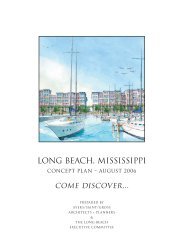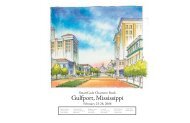Reports - Mississippi Renewal
Reports - Mississippi Renewal
Reports - Mississippi Renewal
- No tags were found...
Create successful ePaper yourself
Turn your PDF publications into a flip-book with our unique Google optimized e-Paper software.
4 | REACHING OUT“We all recognize thatKatrina brought the kindof change we would neverseek, and it is clear that weare determined that it willonly strengthen our communityand our character.”— Chuck Benvenutti,Hancock County Chairman“Stone County is poisedto bring projects to thetable in a hurry.”— Jill Holleman,Stone County Chairman“It is clear that developinga long-range plan andkeeping the vision in focusis a daunting task, butconsider this — we’vesurvived the most devastatinghurricane in our history,and we are a strongercommunity as a result. It isessential that we cometogether on the overallvision for our future with aplan that embraces andenhances those qualitiesthat have made HarrisonCounty and its municipalitiesinto such a specialplace.”— Anthony Topazi,Harrison County Chairman.suggestions and comments via email,telephone, and an online Internetcommunity forum established by theCommission. The Commission’s websitenot only reached out to Englishspeakingcitizens but was translatedinto Spanish and Vietnamese, the nativetongues of many Coast residents. TheCommission listened to these opinionsand considered them carefully as the issueswere debated in committees andthe final recommendations were madein this report. The process of publicparticipation helps to ensure that thisbody of work is reflective of the generalwill of the people it seeks to serve.The Commission divided the areaaffected by Katrina into eight countycommittees — one committee foreach of the six southernmost countiesof Hancock, Harrison, Jackson, PearlRiver, Stone and George; a Southeast<strong>Mississippi</strong> Committee, and a Southwest<strong>Mississippi</strong> Committee. TheSoutheast <strong>Mississippi</strong> Committee wascomprised of Rankin, Scott, Newton,Lauderdale, Simpson, Smith, Jasper,Clarke, Covington, Jones, Wayne, Lamar,Forrest, Perry, and Greene Counties.The Southwest <strong>Mississippi</strong> Committeeconsisted of Hinds, Copiah,Adams, Franklin, Lincoln, Lawrence,Jefferson Davis, Wilkinson, Amite, Pike,Walthall, and Marion Counties. Eachcommittee held multiple town hallmeetings across their geographic area.Most meetings began with a shortvideo presentation that illustrated thedevastation wrought by Katrina andthe hope that has followed. Next, thecounty committee chairman or otherCommission member discussed thework of the Commission and the proposalsthat had been developed. Theaudience then was invited to voice itsconcerns about rebuilding, point outspecific problems in their area, critiqueCommission proposals, and giveideas on recovery. Numerous city andcounty officials attended, participatingin the discussion and listening to theconcerns of their constituents. In additionto general town hall meetings todiscuss a wide range of future plans, theCommission also held public meetingsin each of the 11 coastal cities to presentand discuss the designs and ideasgenerated during the <strong>Mississippi</strong> <strong>Renewal</strong>Forum.The nature and extent of Katrina’s effectsvary over South <strong>Mississippi</strong>. Whilecoastal counties are faced with destroyedinfrastructure and obliterationof their tax base, some inland countiesencounter swells in their population,increased property values, and a heavilyused but limited infrastructure capacity.Below is a summary of the input gatheredfrom the public meetings and theperspectives on problems and opportunitiesfacing South <strong>Mississippi</strong>ans.Six Southernmost CountiesThe Commission’s town hall meetingsattracted standing-room-onlycrowds in Hancock, Harrison, Jackson,George, Stone and Pearl River Counties,and residents voiced their opinionson how their neighborhoods, streets,downtowns and communities shouldbe rebuilt and renewed.The residents of the most heavilydamaged areas faced the dauntingchallenge of engaging in the long-termvision of their community while dealingwith the current, basic needs ofshelter, food, clothing, employment,childcare, and application for assistance.The Commission recognized the difficultproposition of asking citizens onthe Coast to think about their communitiesin 2015 when so many per-




